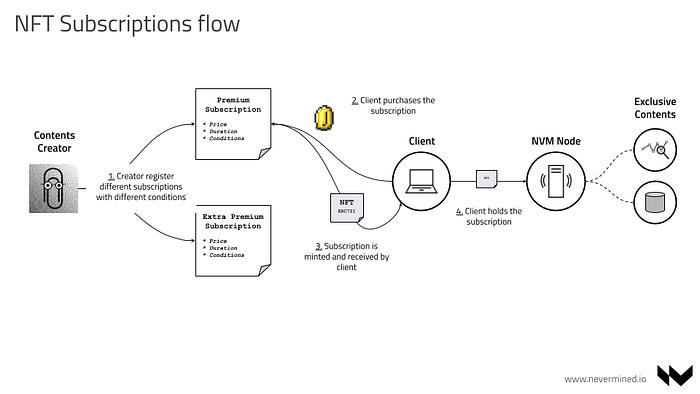Bringing online subscriptions into Web3 and making them Smart
Access Credits
6 min readRead about our new feature, Smart Subscriptions, and how they remodel online subscriptions.

The problem with subscriptions in Web2
In the digital world, the subscription model works. It allows content creators or distributors to protect and monetize their content. It is used in every kind of industry or use case you can imagine. And the versions range from a simple newspaper paywall to a subscription model with different tiers granting access to different types of contents or services.
Traditionally, digital platforms build these services with technology that stores the details and conditions of every user subscription in their own systems and databases. In most of the cases, a subscriber can use their subscription via authentication with their email and password. The platform checks who you are, as well as the subscription details in their database. This process helps to determine what you can and can’t do.
This model has some limitations though. The thing you are purchasing here (the subscription) is something that only exists in the database of the platform you are trying to access. It’s something static and owned and controlled by that platform. This subscription can disappear or be removed unilaterally by the platform leaving the user without it.
Also, that subscription is something totally illiquid. What if, one month after purchasing a one year subscription, you figure out you don’t need that anymore. It would be great if you could go to a secondary market and sell that subscription to someone else.
“Not a big problem for the subscription provider,” we hear you say. But we disagree, for two reasons.
One is up-selling. Sleeping on top of unused subscriptions is not a good long term business if you expect these subscriptions to be renewed. So it is better that your service is used by users interested in your contents.
Two, new revenue. What if you could include a royalties commission in the subscription, which pays a fee if it is sold in the secondary market.
That’s where Web3 and NFTs come in.
What utility do NFTs bring to online subscriptions?
It’s important to note that an NFT can represent much more than a JPEG of a monkey. The concept is a million times stronger and, as Web3 matures, the use cases are becoming much more interesting.
Back to basics: an NFT simply represents the ownership of something by a user in a digital environment. It works pretty well to identify that the user in control of some credentials owns something and can ‘do stuff’ with it: trade it, exchange it, track it and destroy it.
So imagine if an NFT represents the ownership of a specific subscription. That subscription can be minted by the digital platform and transferred to the buyer. Embedded into that NFT are conditions, i.e. that subscription can have a duration and expiry date. The platform using this system can validate that a user owns or holds a specific NFT, identifying that user as a valid subscriber.
But how is this different from regular subscriptions?
The main difference here is who “owns” the subscription. With a traditional platform, the ownership lies with the company and the record sits in the company’s database. In Web3, the NFT sits in your wallet, so the subscriber is in control.
This opens an interesting dimension because effectively your subscription becomes a liquid asset. And as the sole owner of your subscription you can use it in the same way as any digital asset: you can resell it, rent it, transfer it to someone else, even burn it or even combine it with other subscriptions.
This can open new revenue streams for the subscription-based platforms. Because, just as with music NFTs or art NFTs, you can inject royalty conditions into these subscriptions.
For example a viable scenario would be the following:
With KETFLIX we provide multimedia content to our subscribers. The subscriptions depend on the channels, duration of the subscription and price. We use NFT tech to commercialize the subscriptions and include a 10% royalty, paid to KETFLIX if the subscription is resold in the secondary market.
Or from the subscriber point of view:
We purchased a one year subscription to KETFLIX, but after a while we realized we were not using it. So we sold it to a friend with some discount but at least we recovered part of what we paid initially.

Smart Subscriptions, a new feature in the Nevermined stack
In Nevermined we provide interactivity to digital Web3 assets like NFTs. That means we augment NFTs to provide more advanced functionalities like sell & purchase flows, exclusive access to NFT holders, secondary markets, royalties, etc.
And one of those advanced NFT functionalities is Smart Subscriptions, a new extension …on top of the ERC-721 standard. The key functionality is that, during the minting process, the contract owner (in our case the digital platform emitting the subscriptions) can define the expiration of the token.

As you can see in the above image the flow works as follows:
- A content creator who wants to monetize their content or service registers the different types of subscriptions they want to offer. This could include different kinds of content, different prices, duration of the subscription, etc. Each subscription is registered in Nevermined as an asset integrated with an independent ERC-721 contract.
- The client can purchase the different subscriptions available in the content creator site.
- The Nevermined system validates the payment, distributes the rewards and mints the subscription, which is sent to the client
- Now the person holding the Smart Subscription can access all content.
As with all our features, the Smart Subscription functionality is available via our SDK and Catalog.
How is this implemented in Nevermined?
By extension, this mechanism works in any other scenario that requires a form of access ownership to a specific service. Think annual gym memberships. Think of weekly food deliveries. Just think, Web3-style.
At Nevermined, we make a point of putting our own tech through its paces, develop POCs, eat our own dog food and learn.
We have a team that is currently using Nevermined to build a DeFi Data Marketplace and they realized that the Smart Subscription model also applied to the concept of DeFi Data. In our previous version of the marketplace, users were able to get access to free or paid DeFi data provided in a normalized manner via a Marketplace. But we found out the flow was not the best because every download required some blockchain interaction, which added complexity.
To facilitate the user interactions we introduced the DeFi Marketplace subscriptions. With this functionality, users can decide what data they need and select the subscription required. When a DeFi Data user wants access to a specific asset (data set) and they own the correct Smart Subscription, they can download the files directly without any blockchain interaction.

Want to know more?
If you want to know more about Nevermined, go to our website or explore our Documentation.
And we’d love to hear from you. Got any questions, suggestions or want to chat about your project? Contact us via the website or join our Discord.
Kudos points: if you enjoyed this article, let us know by sharing it with someone who should read this too.
Thanks to Gerrie and Rod for their comments and suggestions in the preparation of this post.
Originally posted on 2022-10-28 on Medium.